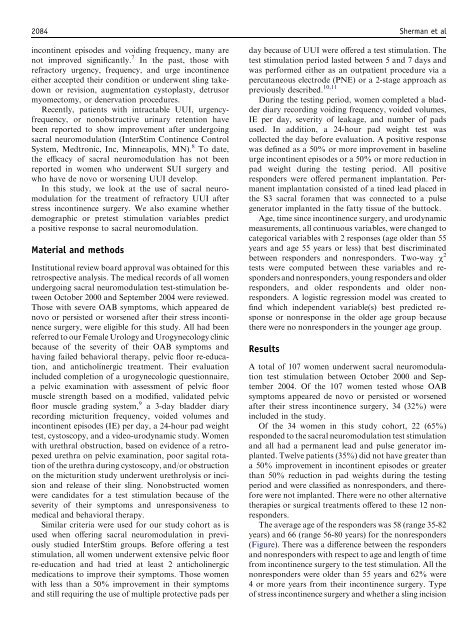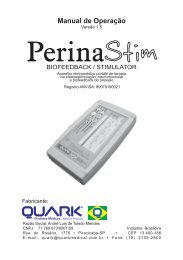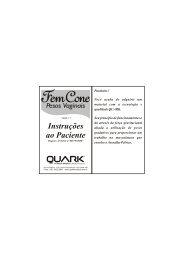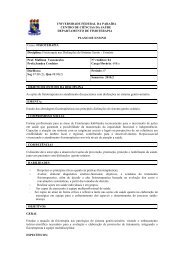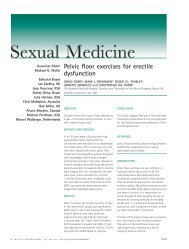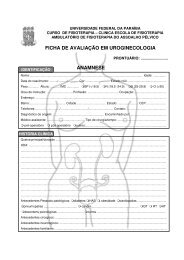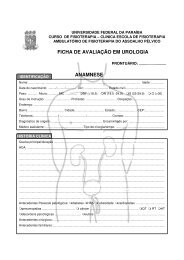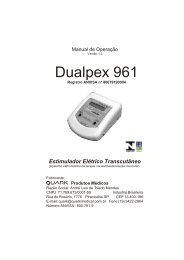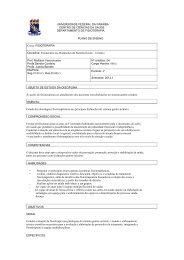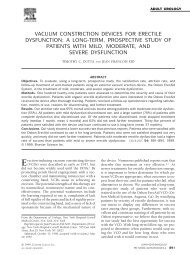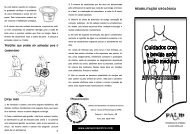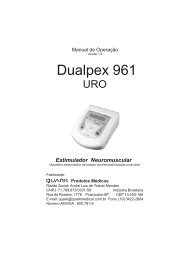Sacral neuromodulation for the treatment of refractory urinary urge ...
Sacral neuromodulation for the treatment of refractory urinary urge ...
Sacral neuromodulation for the treatment of refractory urinary urge ...
You also want an ePaper? Increase the reach of your titles
YUMPU automatically turns print PDFs into web optimized ePapers that Google loves.
2084 Sherman et al<br />
incontinent episodes and voiding frequency, many are<br />
not improved significantly. 7 In <strong>the</strong> past, those with<br />
<strong>refractory</strong> <strong>urge</strong>ncy, frequency, and <strong>urge</strong> incontinence<br />
ei<strong>the</strong>r accepted <strong>the</strong>ir condition or underwent sling takedown<br />
or revision, augmentation cystoplasty, detrusor<br />
myomectomy, or denervation procedures.<br />
Recently, patients with intractable UUI, <strong>urge</strong>ncyfrequency,<br />
or nonobstructive <strong>urinary</strong> retention have<br />
been reported to show improvement after undergoing<br />
sacral <strong>neuromodulation</strong> (InterStim Continence Control<br />
System, Medtronic, Inc, Minneapolis, MN). 8 To date,<br />
<strong>the</strong> efficacy <strong>of</strong> sacral <strong>neuromodulation</strong> has not been<br />
reported in women who underwent SUI s<strong>urge</strong>ry and<br />
who have de novo or worsening UUI develop.<br />
In this study, we look at <strong>the</strong> use <strong>of</strong> sacral <strong>neuromodulation</strong><br />
<strong>for</strong> <strong>the</strong> <strong>treatment</strong> <strong>of</strong> <strong>refractory</strong> UUI after<br />
stress incontinence s<strong>urge</strong>ry. We also examine whe<strong>the</strong>r<br />
demographic or pretest stimulation variables predict<br />
a positive response to sacral <strong>neuromodulation</strong>.<br />
Material and methods<br />
Institutional review board approval was obtained <strong>for</strong> this<br />
retrospective analysis. The medical records <strong>of</strong> all women<br />
undergoing sacral <strong>neuromodulation</strong> test-stimulation between<br />
October 2000 and September 2004 were reviewed.<br />
Those with severe OAB symptoms, which appeared de<br />
novo or persisted or worsened after <strong>the</strong>ir stress incontinence<br />
s<strong>urge</strong>ry, were eligible <strong>for</strong> this study. All had been<br />
referred to our Female Urology and Urogynecology clinic<br />
because <strong>of</strong> <strong>the</strong> severity <strong>of</strong> <strong>the</strong>ir OAB symptoms and<br />
having failed behavioral <strong>the</strong>rapy, pelvic floor re-education,<br />
and anticholinergic <strong>treatment</strong>. Their evaluation<br />
included completion <strong>of</strong> a urogynecologic questionnaire,<br />
a pelvic examination with assessment <strong>of</strong> pelvic floor<br />
muscle strength based on a modified, validated pelvic<br />
floor muscle grading system, 9 a 3-day bladder diary<br />
recording micturition frequency, voided volumes and<br />
incontinent episodes (IE) per day, a 24-hour pad weight<br />
test, cystoscopy, and a video-urodynamic study. Women<br />
with urethral obstruction, based on evidence <strong>of</strong> a retropexed<br />
urethra on pelvic examination, poor sagital rotation<br />
<strong>of</strong> <strong>the</strong> urethra during cystoscopy, and/or obstruction<br />
on <strong>the</strong> micturition study underwent urethrolysis or incision<br />
and release <strong>of</strong> <strong>the</strong>ir sling. Nonobstructed women<br />
were candidates <strong>for</strong> a test stimulation because <strong>of</strong> <strong>the</strong><br />
severity <strong>of</strong> <strong>the</strong>ir symptoms and unresponsiveness to<br />
medical and behavioral <strong>the</strong>rapy.<br />
Similar criteria were used <strong>for</strong> our study cohort as is<br />
used when <strong>of</strong>fering sacral <strong>neuromodulation</strong> in previously<br />
studied InterStim groups. Be<strong>for</strong>e <strong>of</strong>fering a test<br />
stimulation, all women underwent extensive pelvic floor<br />
re-education and had tried at least 2 anticholinergic<br />
medications to improve <strong>the</strong>ir symptoms. Those women<br />
with less than a 50% improvement in <strong>the</strong>ir symptoms<br />
and still requiring <strong>the</strong> use <strong>of</strong> multiple protective pads per<br />
day because <strong>of</strong> UUI were <strong>of</strong>fered a test stimulation. The<br />
test stimulation period lasted between 5 and 7 days and<br />
was per<strong>for</strong>med ei<strong>the</strong>r as an outpatient procedure via a<br />
percutaneous electrode (PNE) or a 2-stage approach as<br />
previously described. 10,11<br />
During <strong>the</strong> testing period, women completed a bladder<br />
diary recording voiding frequency, voided volumes,<br />
IE per day, severity <strong>of</strong> leakage, and number <strong>of</strong> pads<br />
used. In addition, a 24-hour pad weight test was<br />
collected <strong>the</strong> day be<strong>for</strong>e evaluation. A positive response<br />
was defined as a 50% or more improvement in baseline<br />
<strong>urge</strong> incontinent episodes or a 50% or more reduction in<br />
pad weight during <strong>the</strong> testing period. All positive<br />
responders were <strong>of</strong>fered permanent implantation. Permanent<br />
implantation consisted <strong>of</strong> a tined lead placed in<br />
<strong>the</strong> S3 sacral <strong>for</strong>amen that was connected to a pulse<br />
generator implanted in <strong>the</strong> fatty tissue <strong>of</strong> <strong>the</strong> buttock.<br />
Age, time since incontinence s<strong>urge</strong>ry, and urodynamic<br />
measurements, all continuous variables, were changed to<br />
categorical variables with 2 responses (age older than 55<br />
years and age 55 years or less) that best discriminated<br />
between responders and nonresponders. Two-way c 2<br />
tests were computed between <strong>the</strong>se variables and responders<br />
and nonresponders, young responders and older<br />
responders, and older respondents and older nonresponders.<br />
A logistic regression model was created to<br />
find which independent variable(s) best predicted response<br />
or nonresponse in <strong>the</strong> older age group because<br />
<strong>the</strong>re were no nonresponders in <strong>the</strong> younger age group.<br />
Results<br />
A total <strong>of</strong> 107 women underwent sacral <strong>neuromodulation</strong><br />
test stimulation between October 2000 and September<br />
2004. Of <strong>the</strong> 107 women tested whose OAB<br />
symptoms appeared de novo or persisted or worsened<br />
after <strong>the</strong>ir stress incontinence s<strong>urge</strong>ry, 34 (32%) were<br />
included in <strong>the</strong> study.<br />
Of <strong>the</strong> 34 women in this study cohort, 22 (65%)<br />
responded to <strong>the</strong> sacral <strong>neuromodulation</strong> test stimulation<br />
and all had a permanent lead and pulse generator implanted.<br />
Twelve patients (35%) did not have greater than<br />
a 50% improvement in incontinent episodes or greater<br />
than 50% reduction in pad weights during <strong>the</strong> testing<br />
period and were classified as nonresponders, and <strong>the</strong>re<strong>for</strong>e<br />
were not implanted. There were no o<strong>the</strong>r alternative<br />
<strong>the</strong>rapies or surgical <strong>treatment</strong>s <strong>of</strong>fered to <strong>the</strong>se 12 nonresponders.<br />
The average age <strong>of</strong> <strong>the</strong> responders was 58 (range 35-82<br />
years) and 66 (range 56-80 years) <strong>for</strong> <strong>the</strong> nonresponders<br />
(Figure). There was a difference between <strong>the</strong> responders<br />
and nonresponders with respect to age and length <strong>of</strong> time<br />
from incontinence s<strong>urge</strong>ry to <strong>the</strong> test stimulation. All <strong>the</strong><br />
nonresponders were older than 55 years and 62% were<br />
4 or more years from <strong>the</strong>ir incontinence s<strong>urge</strong>ry. Type<br />
<strong>of</strong> stress incontinence s<strong>urge</strong>ry and whe<strong>the</strong>r a sling incision


